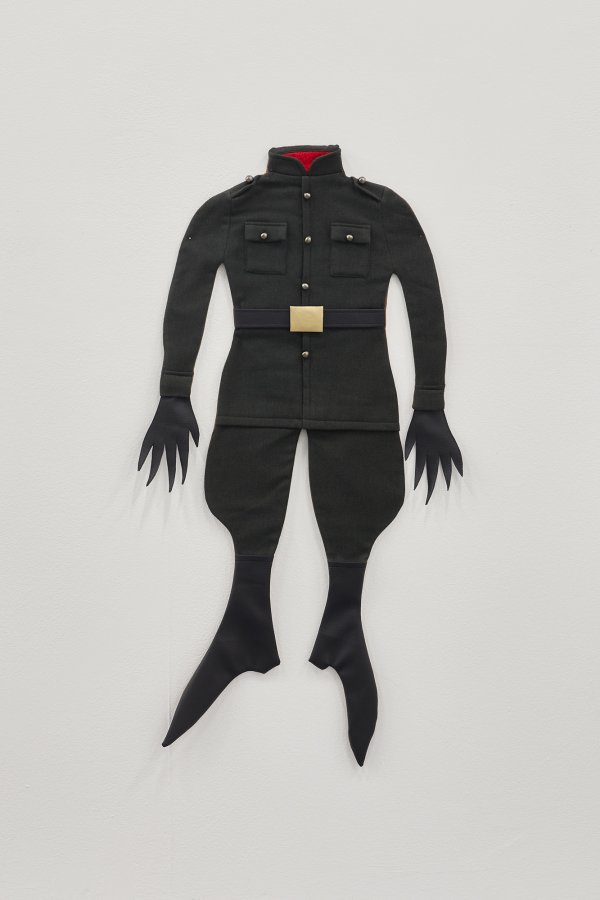Julie Béna
The wolf, the princess and the little soldier
3.12.2020–15.5.2021 Prague- Text (EN)
- Text (CZ)
“In the midst of the inescapable lockdown with a child, I decided not to escape or project out, but to do a show for her. A show, where there is a princess and a wolf, a magic mirror, some legs, a puppet theatre and a drunken sailor. Twelve fabric books and three birds. All these characters, who live in our stories, the ones before sleep, as an echo of glorious and sad days, a producer of fear and happiness, and a central vapour for this night brain.”
Although the last taboo in contemporary art may be honest illustrative childishness, not as an ironic position to mock and underline the author’s own importance, or another land of aesthetics that the field may invade and exploit, but as to really share something gentle and funny with the little ones, Julie Béna’s furry characters open deeper questions about the gendered constitution of art’s authorship. By performing the “artist-mother”, Béna reflects on the naturalized constitution of “single-” “available-” or simply “male-artist-without-commitment” and therefore denaturalizes it.
What we see is not only a gesture or a manifestation of the theory or field of research of a conceived project, but simply an everyday lived reality that the artist doesn’t want to artificially divide from her own creative practice, as would rather be recommended to keep the “standards” of professionalism. This, however, also creates a challenge. An exhibition for children would only remain gestural, but what we see is equally an exhibition for adults. It is a development on Béna’s long term work on theatricality that (again) in performing certain exaggerated features of objects and characters, uncovers the supposed natural constitution of gender defining terms such as “cuteness”, “powerfulness”, “fragility”, “trickiness”, “wiseness”, “treacherousness” etc., which are an ideal source of material for fairy-tales.
The exhibition does not stay at only the fairy-taleness, but further develops the themes of the theatrical and scenographic, always present in Béna’s work, also as creative mechanisms that allow for certain channelling. Béna presents the theater as a metaphor for a world where everything is staged, but emotions, laughter and tears, are, as with children, always experienced as real. By animating these stereotypes, by giving them bodies and needs, these monstrosities suddenly become fragile and weak. Finally in their weakness, they are able to be loved.
“Uprostřed lockdownu, ze kterého nebylo úniku a který jsem trávila s dítětem, jsem se rozhodla nesnažit se uniknout, nesnít o tom, co by mohlo být, ale vytvořit pro svou dceru výstavu. Výstavu, kde je princezna a vlk, kouzelné zrcadlo, nějaké ty nohy, loutkové divadlo a opilý námořník. Dvanáct látkových knížek a tři ptáci. Všechny tyto postavy, které žijí v našich příbězích, které si vyprávíme před spaním, jako ozvěna těch slavných a smutných časů, výrobce strachu a štěstí a centrální výdech tohoto nočního mozku.”
Ačkoliv posledním tabu v současném umění může být upřímná ilustrativní dětinskost, ne coby ironický postoj sloužící k zesměšňování a zdůrazňování autorčiny důležitosti, případně jako jiná země estetiky, do které může pole současného umění vpadnout a využít ji, ale jako skutečné sdílení něčeho laskavého a legračního s našimi nejmenšími. V tomto smyslu také chlupaté postavičky Julie Bény otevírají hlubší otázky, týkající se genderové konstituce autorství v umění. Performováním role “umělkyně - matky” Béna reflektuje také naturalizovanou podstatu pojmů “nezadaná/ý”, “dostupná/ý” nebo prostě “umělec - muž bez závazků” a tudíž toto uspořádání denaturalizuje.
Ale to, co vidíme, není jen gesto, ani projev na téma teorie nebo v oblasti výzkumně koncipovaného projektu, ale pouze každodenní realita, kterou umělkyně nechce uměle oddělit od své vlastní tvůrčí praxe, jak bývá doporučováno kvůli dodržení “standardů” profesionality. Toto však také vytváří výzvu: výstava pro děti by zůstala pouze gestem, ale to, co vidíme, je stejně tak výstava pro dospělé, vývoj dlouhodobé práce Bény o divadelnosti, která (opět) předváděním určitých přehnaných rysů předmětů a postav odkrývá domněle přirozenou podstatu pojmů definujících gender jako „roztomilost“, „mocnost“, „křehkost“, „záludnost“, „moudrost“, „zrádnost“ atd., pro které jsou pohádky ideálním zdrojem materiálu.
Výstava však nestojí pouze na pohádkovosti, ale dále rozvíjí divadelní a scénografická témata, která jsou v díle Bény vždy přítomna také jako tvůrčí mechanismy, jež umožňují určité usměrňování. Béna také představuje divadlo jako metaforu světa, kde je vše inscenováno, ale emoce, smích a slzy jsou, stejně jako u dětí, vždy prožívány skutečně. Oživováním těchto stereotypů, tím, že jim dáváme těla a potřeby, se najednou s celou jejich obludností stávají křehkými a mohou být oslabeny. A konečně v jejich slabosti mohou nalézt schopnost být milováni.








































